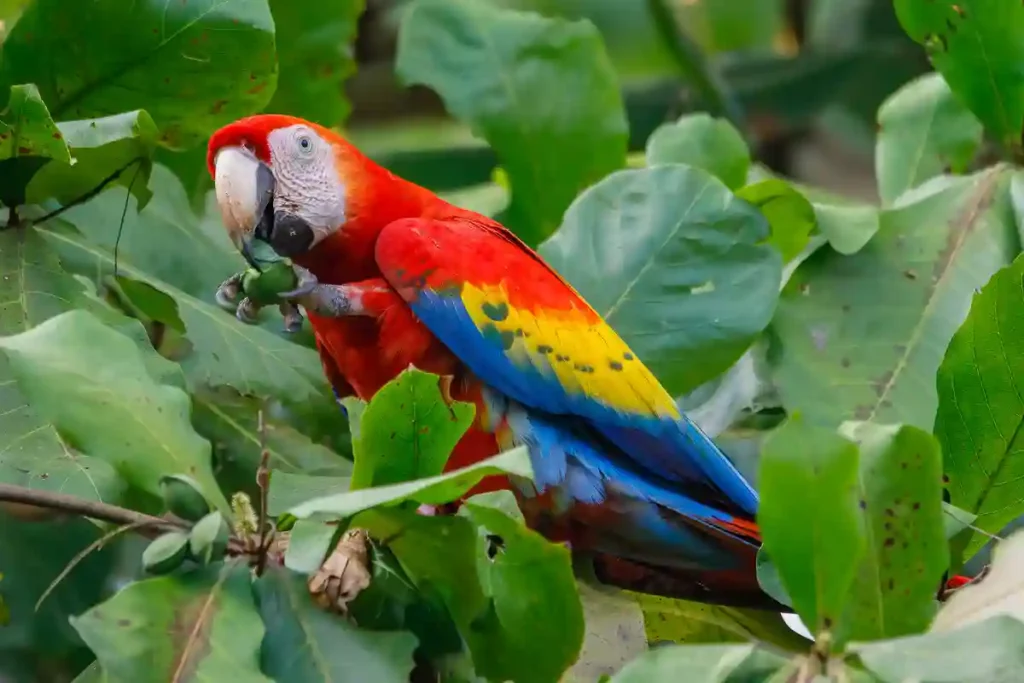Scarlet Macaw
The Scarlet Macaw (Ara macao) is one of the most dazzling and charismatic birds in the Neotropics, instantly recognizable by its vibrant red, yellow, and blue plumage and powerful calls. It plays a vital role in seed dispersal and forest ecology. In Costa Rica, Scarlet Macaws are mostly found along the Pacific coast, with strongholds…

Ara macao
Scientific Name
Psittacidae
Family
Psittaciformes
Order
Ara macao macao
Subspecies. Found in South America.
Ara macao cyanoptera
Subspecies. Found in Central America, including Costa Rica.
Range and Habitat of Scarlet Macaw
Geographic Range
From southern Mexico through Central America to parts of South America.
Migratory Patterns
Non-migratory; resident throughout its range.
Preferred Habitat
Humid lowland rainforests, open woodlands, and river edges.
Altitude Range
Up to 1,000 meters (3,280 feet).
Costa Rica Habitat
Pimarily found in the Pacific lowlands, notably in areas like Carara National Park and the Osa Peninsula.
Conservation Status
Least Concern
Conservation Status
Population Status
In Costa Rica populations are localized and recovering in some areas, but still vulnerable in others due to historical declines from poaching and deforestation.
Habitat loss from logging, agriculture, and tourism development, illegal pet trade (poaching chicks and eggs) and low reproductive rate and dependence on large, old-growth trees for nesting.
Conservation efforts
Macaw Recovery Network: Breeding and reintroduction programs in Nicoya and the Central Pacific, habitat protection in key national parks like Carara and Corcovado, and environmental education programs to reduce illegal trade and encourage ecotourism
Primary Threats
Habitat loss from logging, agriculture, and tourism development, illegal pet trade (poaching chicks and eggs) and low reproductive rate and dependence on large, old-growth trees for nesting.
Scarlet Macaw Identification
How to Identify the Species
Rarity Level:
CommonBest Viewing Times:
Early Morning (Dawn - 8 AM), Evening (Dusk)
Size
Approximately 81 cm (32 inches) in length; weight around 1 kg (2.2 lbs).
Plumage
Predominantly bright red with yellow and blue on the wings; long red tail feathers.
Distinctive Features
Large, strong beak; bare white facial skin with small feather lines.
Sexual Dimorphism
Minimal; males and females appear similar.
Diet and Feeding Behavior
Primary Diet
- Fruits, nuts, seeds, and occasionally clay from riverbanks to neutralize toxins.
Foraging Techniques
- Uses strong beak to crack open hard nuts and seeds; often forages in pairs or small groups.
Feeding Times
- Most active during early morning and late afternoon
Behavior Patterns
Scarlet Macaw
Social Structure
Highly social; typically seen in pairs or small flocks.
Song and Vocalization
Loud, raucous squawks and screams; used for communication within flocks.
Courtship and Mating Ritual
Engage in mutual preening and synchronized flight displays.
Territoriality
Defends nesting sites; otherwise, ranges overlap among groups.
Birdwatching Tips
Best Locations for Spotting Scarlet Macaw
- Carara National Park
- Osa Peninsula (including Corcovado National Park)
- Piedras Blancas National Park
- Golfo Dulce region
- Tarcoles River area

Best Time of the Year
Dry season (December to April) offers better visibility and access to habitats.
Common Behavior
Look for pairs or small groups flying overhead or feeding in canopy trees; listen for their distinctive calls.
Recommended Gear
Binoculars with good light-gathering capability, camera with telephoto lens, and a field guide to Central American birds.
Breeding and Nesting Behavior
Breeding Season
Typically during the dry season; varies by region.
Nesting Sites
Nests in natural cavities of tall trees.
Clutch Size
2–4 eggs.
Incubation Period
Parental Care
Both parents participate in feeding and caring for the chicks.